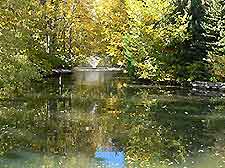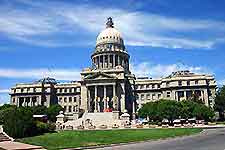Boise History Facts and Timeline
(Boise, Idaho - ID, USA)

The site of the present-day Idaho city of Boise was first seen in 1833 by Captain Benjamin Bonneville. Along with a group of Frenchmen, Bonneville fell in love with the lush, green forests in the area along the Boise River, where the city now stands.
Little else happened for another 30 years, with the riverbanks acting as nothing more than a rest and relaxation site for pioneers heading to
Oregon, farther to the west. In 1863, the modern history of Idaho and Boise received a kick-start when President Abraham Lincoln and Congress declared the region of Idaho an official territory of the United States.
Development and the Civil War
Development followed fast on the heels of the declaration, with Major Pinkney Lugenbeel founding the US military outpost of Fort Boise in 1863, as a replacement for the original Hudson's Bay Company fortress located some 40 miles / 64 km to the west, on the Oregon border. The prime purpose of the new fort, erected during the Civil War (1861 to 1865), was the protection of covered wagon convoys from the increasing Indian massacres along the Oregon Trail. The Civil War had minimal effect on the region, as most of the battles were fought in the Confederate area of the South.
City Status
Boise history took off after the fort was completed, with the growing town designated as the Idaho capital, although formal city government wasn't initiated until 1867. The citizens, however, resisted municipal control, seeing it as an excuse for taxation, with the bustling town in no need of incorporation. Finally, in 1867, the city's first mayor, Henry E Prickett, took office.
Gold Strikes
The original gold and silver discoveries in 1862 were soon augmented by several more finds, with Boise benefiting from the resulting wealth brought to the city by prospectors and businesses serving their needs. By 1868, there were some 400 buildings, half of which were residential. Constructed in 1870, the Idaho State Penitentiary became home to many legendary outlaws and desperadoes over the years. Gold, however, is a limited resource, and supplies began to dry up, threatening the town's economy and decimating its population.

The Farming Era
Boise fell into decline as an isolated location without major transport links and featuring a climate unsuitable for agriculture. A renewed town was designed with shady streets running parallel to the river banks, while irrigation systems were put in place and crops were planted. Sustainable farming, at last, became possible, although by the advent of the 20th century, wagon trails were still the only way to reach the city.
Modernity and WWII
By 1920, Idaho had entered the Union as a state, with Boise the capital. The Union Pacific Railroad came to town in 1925, boosting the city into another period of growth that included the building of dams and reservoirs to permanently answer the region's agricultural and municipal water needs. Hydroelectric power came next, and the military maintained a strong presence in the city during WWII, with an air base and a pilot training facility at Gowen Field.
Post-War Success
Boise's modern history is positive, with the new city charter established in the 1960s allowing the rapidly expanding conurbation to annex more suburban areas, thus relieving pressure on housing stocks.
As a result, Boise's population doubled and the growth factor, influenced by a pleasant climate, urban renewal and a high quality of life, has continued to promote development into the 21st century.
 The site of the present-day Idaho city of Boise was first seen in 1833 by Captain Benjamin Bonneville. Along with a group of Frenchmen, Bonneville fell in love with the lush, green forests in the area along the Boise River, where the city now stands.
The site of the present-day Idaho city of Boise was first seen in 1833 by Captain Benjamin Bonneville. Along with a group of Frenchmen, Bonneville fell in love with the lush, green forests in the area along the Boise River, where the city now stands.